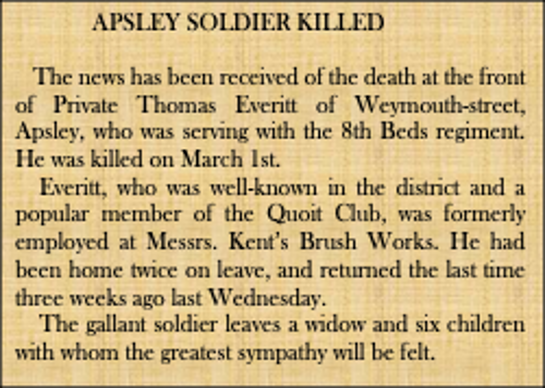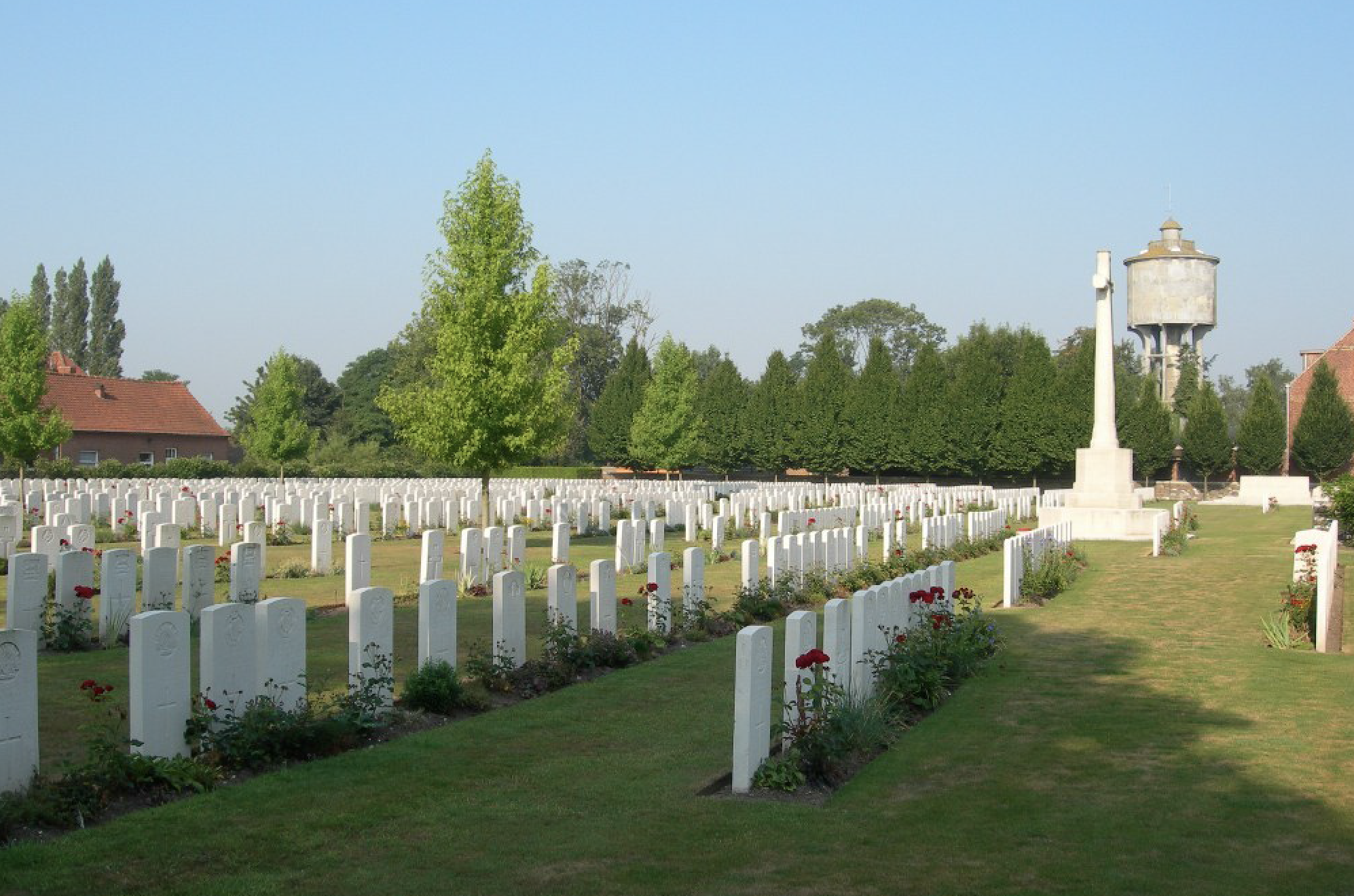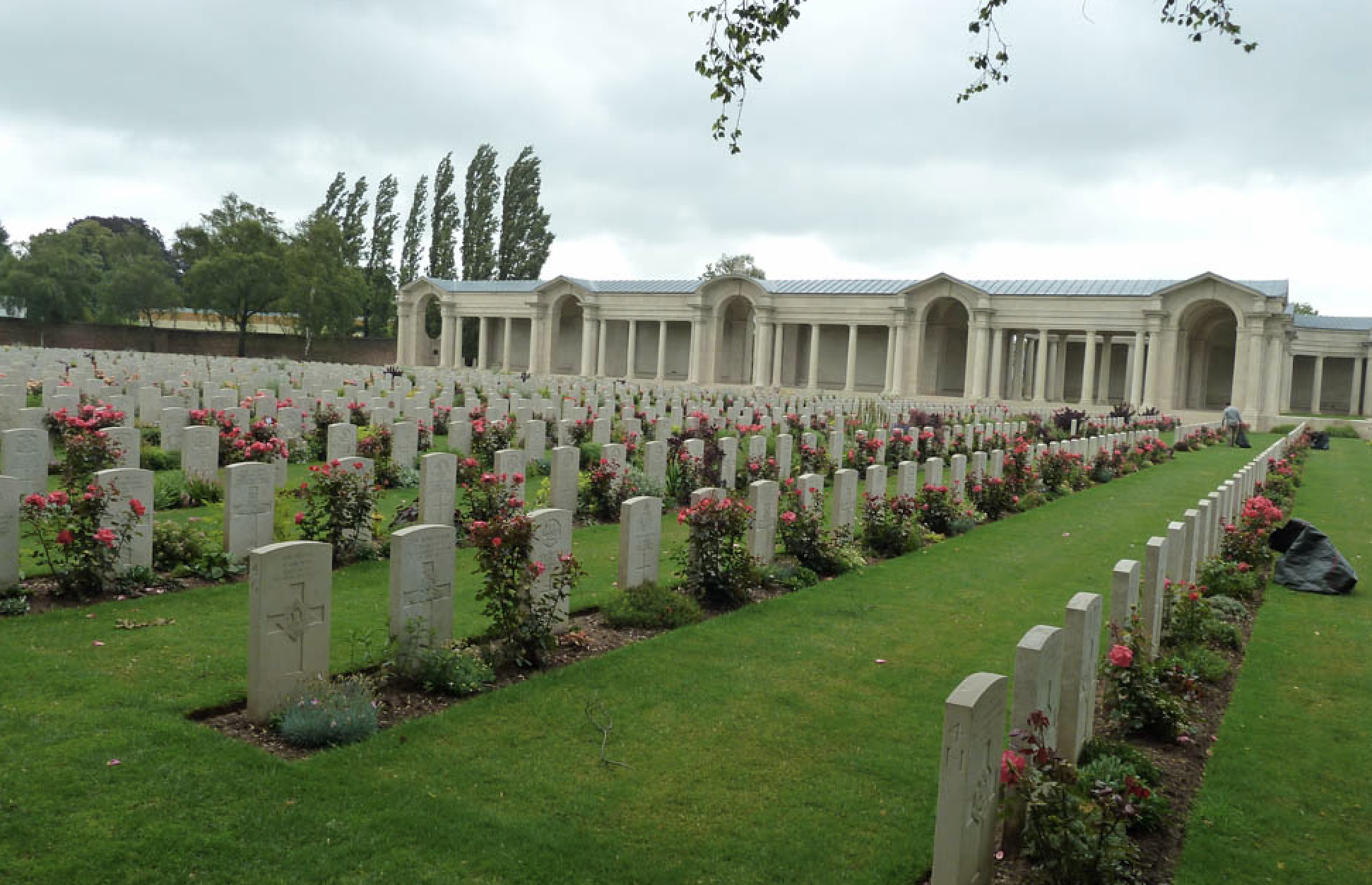Fallen in March 1916:
Arthur Thomas Everitt
William Gamble
ARTHUR THOMAS EVERITT
3/8430 Private
8th Bn., Bedfordshire Regiment
Killed in Action Wednesday, 1st March 1916
Remembered with Honour Menin Road South Military Cemetery, West-Vlaanderen, Belgium, Grave I.L.15.
Arthur Thomas Everitt, known as Thomas to his family, was born in Luton, Bedfordshire in 1880 the oldest child of Thomas and Rhoda Everitt. He had five younger siblings who were: Sidney, Fred, Stanley, Ellen and Mabel and when he was born the family lived at 61 Salisbury Road, Luton close to where his father plied his trade as a Butcher.
Young Thomas met local girl Rosa Smith in around 1894 and three years later in 1897 they married in Luton. Their first child Sidney was born the following year. Thomas moved with Rosa and Sidney in 1898 to start work as a ‘Stock-Keeper’ with Dickinson & Co. Ltd. at Apsley Mills and the family settled in their new home at 19 Weymouth Street in Apsley End.
Thomas and Rosa had five more children who were: Nellie, Florie, Stanley, Albert and Rosa and by 1911 the family had moved a few yards to 24, Weymouth Street. Thomas was still working in Dickinsons and he was listed as a ‘Paper Maker’.
Sometime
before the start of the war Thomas changed jobs and moved to G.B. Kent &
Sons the brush makers, but still in Apsley. He would remain with the firm until
he joined the colours.
On the outbreak of war Thomas enlisted in the Bedfordshire Regiment, attesting at Watford in October 1914 and he was posted to the newly formed 8th Battalion at Bedford. The 8th Battalion was a "Service" battalion that was formed specifically for the duration of the war as part of 'K3' - Lord Kitchener's third 'call to arms' for another 100,000 men. It was attached to the 71st Brigade of the 24th Division and remained there for a year, before transferring twice to end up with the 16th Brigade of the 6th Division.
Thomas undertook his basic training initially in Brighton for a brief spell, but then for almost seven months in the sprawling New Army training area around Woking in Surrey. Finally, the increasingly restless men of the 'Hungry 8th' (a nickname used in a letter home from Private 19861 Leslie Worboys) received orders to mobilise and prepared to ship out. At 11pm on the 28th August 1915, the Battalion boarded the troop trains at Chobham Station and left for Dover. After transferring straight onto troop ships, the troops arrived at Boulogne early on the 30th August 1915.
Within a month of disembarking in France Thomas saw action in The Battle of Loos. He was also in the line at Forward Cottage trenches north of Ypres, when the Army experienced the first German use of Phosgene gas on the 17th December and hundreds of men were lost in the attack.
Thomas returned home on leave for a short time in early February 1916 before returning to France on the 16th of the month. He would never return again.
By the 24th February 1916 he was back with the battalion which had moved to Ypres and Thomas was involved in trench work before moving up to the frontline and the position close to the Menin Road on the 29th of the month. The following day the battalion War Diary records the following: "1 Mar 1916 - trenches near Ieper In trenches right section 16 IB sector. - Bn HQrs and C Coy Ecole de Bienfaisance, A Coy 2 platoons MENIN CELLARS, 2 platoons X.1.A., B Coy H13-H15, F6, F11, D Coy H16, 17 & 19 & S18. Killed O.R. 1, wounded O.R. 2"
Thomas was the ‘O. R.’ killed on Wednesday, 1st March 1916.
A brief
report of his death appeared in the Hemel Gazette ten days later. (see extract)
He is commemorated on the memorial plaque at G.B. Kent & Sons where he worked and at St. Mary’s Parish Church, Apsley where he worshipped.
Thomas is Remembered with Honour in Menin Road South Military Cemetery, West-Vlaanderen, Belgium, where he is interred in Grave I.L.15. The inscription on his headstone requested by his wife Rosa reads: “A LOVING FATHER A FATHER KIND A BEAUTIFUL MEMORY LEFT BEHIND”.
He was 36 years old when he died. Thomas was eligible for the 1914-15 Star, the British War Medal and the Allied Victory Medal.
G.B.Kent & Sons factory in Apsley where Thomas worked (Courtesy:https://kentbrushes.com/)
Extract from The Hertfordshire, Hemel Hempstead Gazette and West Herts Advertiser 11th Mar. 1916
G.B.Kent & Sons Memorial Plaque (Courtesy: http://www.hemelatwar.org)
Menin Road South Military Cemetery, West-Vlaanderen, Belgium (Courtesy: CWGC)
WILLIAM GAMBLE
15577 Private
1st Bn., Bedfordshire Regiment
Killed in Action Thursday, 30th March 1916
Remembered with Honour Faubourg d'Amiens Cemetery, Arras, Pas-de-Calais, France, Grave I. A. 5.
Robert
William Gamble, known as William, was born on Wednesday, 2nd April
1890 in Hemel Hempstead, the oldest child of Frederick Gamble and Emma Collier.
He had four siblings who were: Annie, Frederick, Harry and Hilda. Annie died
when she was only a year old in 1892 and William’s youngest brother Harry also
fought in the Great War and he was killed in action at Guillemont in France on the
15th September 1916. His biography is also ion this site.
The Gamble family lived at 57 Horsecroft Road in Boxmoor when William was born, and his father Frederick was a labourer on the railways. Frederick was from Welham in Leicestershire and had come south to Boxmoor with his job in about 1886. He subsequently met a local girl, Emma Collier, and they were married in 1889 in Boxmoor.
William started his education at Boxmoor JMI school on the 18th February 1897 and successfully completed the expected six standards before leaving on the 9th April 1903 to start working. He was thirteen years old and his first job was in a local dairy working for Henry Morgan on Horsecroft Road.
The family were still living at 57 Horsecroft Road in 1911 and William had moved jobs and was working, along with his brother Fred, as a Printer in Dickinson & Co. Ltd. at Apsley Mills. His youngest brother Harry was a Wood Sawyer at G.B. Kent & Sons the brush makers in Apsley.
After William and Harry had enlisted, their mother Emma died aged 48 and she was buried at Heath Lane Cemetery in Hemel Hempstead on the 11th May 1915.
On the outbreak of war William enlisted with the Bedfordshire Regiment and attested at Hemel Hempstead in September 1914. He was initially posted to the 4th Battalion for basic training at Felixstowe, Suffolk and the following year he was sent to France on the 23rd March 1915.
He joined his battalion near Ypres on the 28th March and within four weeks he saw action at the appalling Battle of Hill 60. After the initial capture and subsequent defence, the 1st Battalion lost so many men that they were effectively rebuilt twice during the fighting.
Having survived the actions at Hill 60, William spent the next eleven months in an around the trenches and eventually in March 1916, he found himself with his comrades near Arras in France. They were subject to constant enemy sniping and suffered frequent casualties until, overnight of the 30th and 31st March the battalion War Diary recorded the following: "30 Mar 1916 Search party for body of Lt Whittemore proved futile. Enemy active with Trench Mortars. Retaliation by our Trench Mortars bad, owing to insufficient supply of ammunition."
"31 Mar 1916 …Casualties during tour Killed 1 Officer, 3 O.R. Wounded 1 Officer* 4 O.R. * 2nd Lt.P. Vyvvan 3rd R.W.S.(Queens) Regt attached, on night of 30/31 March."
William was
one of the "3 O.R." killed and he
died on Thursday, 30th March 1916.
William is Remembered with Honour in Faubourg d’Amiens Cemetery, Arras, Pas-de-Calais, France, where he is interred in Grave I. A. 5.
He was 26 years old when he died. William was eligble for the 1915-15 Star, the British War Medal and the Allied Victory Medal.
Pte. William Gamble c1914 (Courtesy: The Hertfordshire, Hemel Hempstead Gazette and West Herts Advertiser)
Pte. William Gamble's headstone (Courtesy: Traquair Photography May 2017)
Faubourg d’Amiens Cemetery, Arras, Pas-de-Calais, France (Courtesy: CWGC)


